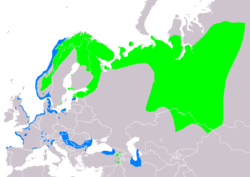| Velvet scoter | |
|---|---|
 | |
| Male | |
 | |
| Female | |
| Scientific classification | |
| Kingdom: | Animalia |
| Phylum: | Chordata |
| Class: | Aves |
| Order: | Anseriformes |
| Family: | Anatidae |
| Genus: | Melanitta |
| Subgenus: | Melanitta |
| Species: | M. fusca |
| Binomial name | |
| Melanitta fusca | |
 | |
| Range of M. fusca Breeding Non-breeding | |
| Synonyms | |
Anas fuscaLinnaeus, 1758 | |
The velvet scoter (Melanitta fusca) is a large sea duck, which breeds over the far north of Europe and the Palearctic west of the Yenisey basin. The genus name is derived from Ancient Greek melas "black" and netta "duck". The species name is from the Latin fuscus "dusky brown".


